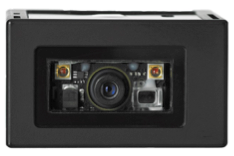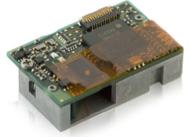As a part of a development team for a laboratory automation system or clinical analyzer, you and your colleagues have been chosen to develop the specimen traceability portion of the instrument. In your mind you believe this should be a fairly easy task, correct? Now tell me, what automation technology will you chose? Will it be laser-based or image-based, and what do you have to consider prior to making your decision?
 Laser and image-based systems both play vital roles in life sciences applications. One of the first, and most basic, evaluations that must be made is whether your project involves the decoding of 2D symbols (such as QR code or Data Matrix) like those that may be found on reagent vessels or on rack background labels. The use of 2D symbols will require you to bypass the laser scanning technology and go straight to an imaging solution. Laser-based readers cannot see the entire area necessary to decode a 2D symbol due to the fact that the unit only illuminates a thin strip of the barcode with their linear laser beam. For clinical applications that require 2D symbol recognition, an imager such as Opticon’s NLV-3101 or MDI-3100 may be just the solution for which you are searching.
Laser and image-based systems both play vital roles in life sciences applications. One of the first, and most basic, evaluations that must be made is whether your project involves the decoding of 2D symbols (such as QR code or Data Matrix) like those that may be found on reagent vessels or on rack background labels. The use of 2D symbols will require you to bypass the laser scanning technology and go straight to an imaging solution. Laser-based readers cannot see the entire area necessary to decode a 2D symbol due to the fact that the unit only illuminates a thin strip of the barcode with their linear laser beam. For clinical applications that require 2D symbol recognition, an imager such as Opticon’s NLV-3101 or MDI-3100 may be just the solution for which you are searching.
Another issue to consider is whether your project requires you to retain an image of the barcode in your system. This statement always leads to the inevitable question of, “why would you retain an image?” Retaining an image can be another way to add value to your final product. Some customers like to keep images of their barcodes to increase their level of traceability, and to help technicians troubleshoot cases where labels are unable to be decoded. Retaining an image requires the use of an image-based system; this is another case where you should reach for an Opticon NLV-3101 or MDI-3100.
 Do you want, or need, to use an image-based solution to accomplish additional tasks beyond decoding 2D symbols? For example, do you need to determine cap absence or presence, cap color, tube measurement, or liquid fill level? Tasks like these are common in applications where inspection is needed prior to sending a sample tube into a test. If, for instance, a tube cap is present and the following step is automated aspiration, detecting cap presence would allow the instrument to bypass the task of aspiration until the tube is uncapped. Or, if the cap color reveals that the sample is not the correct type for the test, or if the tube fill level indicates that the amount of sample is inadequate, the tube can be managed appropriately. In cases such as these, machine vision imagers like Opticon’s MVI-2300 are the right tool for the job.
Do you want, or need, to use an image-based solution to accomplish additional tasks beyond decoding 2D symbols? For example, do you need to determine cap absence or presence, cap color, tube measurement, or liquid fill level? Tasks like these are common in applications where inspection is needed prior to sending a sample tube into a test. If, for instance, a tube cap is present and the following step is automated aspiration, detecting cap presence would allow the instrument to bypass the task of aspiration until the tube is uncapped. Or, if the cap color reveals that the sample is not the correct type for the test, or if the tube fill level indicates that the amount of sample is inadequate, the tube can be managed appropriately. In cases such as these, machine vision imagers like Opticon’s MVI-2300 are the right tool for the job.
 When should a laser-based solution be chosen? By and large, when a project involves decoding a 1D (or linear) barcode, lasers are superior in a couple of ways. The speed at which lasers can decode is much faster than that of imagers because laser scanning happens almost instantaneously. Image-based scanners must first capture an image and process the image in order to decode a barcode. While a typical imager scans at 50 frames per second, a laser reader can scan a target anywhere from 100 to 1000 times per second. For applications where speedy reads are necessary, for example a rotary tube-handling system where the target is in motion, lasers will continue to remain the go to choice. Another factor to consider is distance at which a barcode is to be read; lasers are typically able to decode over a greater range of distances. Consider an Opticon MDL-1000 or NLB-1000 when faced with an application where speed is of the essence or long distance scans are required.
When should a laser-based solution be chosen? By and large, when a project involves decoding a 1D (or linear) barcode, lasers are superior in a couple of ways. The speed at which lasers can decode is much faster than that of imagers because laser scanning happens almost instantaneously. Image-based scanners must first capture an image and process the image in order to decode a barcode. While a typical imager scans at 50 frames per second, a laser reader can scan a target anywhere from 100 to 1000 times per second. For applications where speedy reads are necessary, for example a rotary tube-handling system where the target is in motion, lasers will continue to remain the go to choice. Another factor to consider is distance at which a barcode is to be read; lasers are typically able to decode over a greater range of distances. Consider an Opticon MDL-1000 or NLB-1000 when faced with an application where speed is of the essence or long distance scans are required.
In conclusion, if you need to decode 2D symbols, retain label images, or perform machine vision inspection tasks, an image-based system is the Auto ID solution to choose. If you need to optimize decode speed and scan distance for 1D codes, a laser based system offers the best solution.
About the Author
 Robert Maxwell, Jr. is a Client Relationship Manager for RESCO Electronics, a Baltimore Based manufacturer of electronic assemblies and value added reseller of auto ID equipment to original equipment manufacturers.
Robert Maxwell, Jr. is a Client Relationship Manager for RESCO Electronics, a Baltimore Based manufacturer of electronic assemblies and value added reseller of auto ID equipment to original equipment manufacturers.
Prior to joining RESCO in 2011, Robert was the Marketing Director for Shockwave Magazine, Baltimore’s only still in print music magazine. During his time at Shockwave Magazine, Robert developed Fringe Focus Marketing Solutions which transformed into a management firm for a wide range of, both local and national, artists encompassing many different forms of media.
Robert graduated from The University of Baltimore with a Bachelor’s of Science in Business Administration with a concentration in Marketing. While attending The University of Baltimore, Robert was the Founder and President of the UB Golf Club and Vice President of the Sports Club Council.


